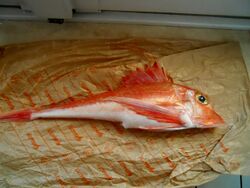Biology:Platycephaloidei
| Platycephaloidei | |
|---|---|

| |
| Bartail flathead (Platycephalus indicus) | |

| |
| Piper gurnard (Trigla lyra) | |
| Scientific classification | |
| Domain: | Eukaryota |
| Kingdom: | Animalia |
| Phylum: | Chordata |
| Class: | Actinopterygii |
| Order: | Scorpaeniformes |
| Suborder: | Platycephaloidei Matsubara, 1943 |
| Families | |
|
See text | |
Platycephaloidei is a suborder of ray-finned fishes, part of the order Scorpaeniformes, and includes the flatheads, ghost flatheads and sea robins.
Taxonomy
Platycephaloidei was first recognised and named as a taxonomic grouping in 1943 by the Japanese ichthyologist Kiyomatsu Matsubara.[1] The 5th edition of Fishes of the World classifies this group as a suborder within the Scorpaeniformes.[2] Other authorities classify the families that make up Patycephaloidei in the 5th edition of Fishes of the World as two suborders; the Platycephaloidei, consisting of the families Bembridae, Parabembridae (separated from Bembridae), Platycephalidae, Hoplichthyidae and Plectrogeniidae (treated as a subfamily of Scorpaenidae in Fishes of the World) and the Trigloidei, including the families Triglidae and Peristediidae.[3] The name of the suborder is taken from that of the type genus Platycephalus which means "flat head".[4]
Families and subfamilies
The following families and subfamilies are classified within the suborder Platycephaloidei:[2][5]
- Triglidae Rafinesque, 1815 (Gurnards and sea robins)
- Prionotinae Kaup, 1873
- Pterygotriglinae Fowler, 1938
- Triglinae Rafinesque, 1815
- Peristediidae Jordan & Gilbert, 1883 (Armoured searobins)
- Bembridae Kaup, 1873 (Deepwater flatheads)
- Platycephalidae Swainson, 1839 (Flatheads)
- Hoplichthyidae Kaup, 1873 (Ghost flatheads)
Characteristics
Platycephaloidei fishes are characterised by having elongate bodies with flattened heads which typically have ridges and spines. There are two separate dorsal fins, the pelvic fins are widely separated and have a single spine and typically 5 soft rays, although the pelvic fins of the genus Hoplichthys has 3 soft rays. The anal fin may contain 0, 1 or 3 spines and between 5 and 18 soft rays. They may or may not have a swimbladder.[2] The flatheads of the family Platycephalidae are the largest fishes within this taxon with some attaining lengths of 70 cm (28 in).[6]
Distribution and habitat
Platycephaloidei fishes, in the sense of the alternative classification to that of Fishes of the World outlined under Taxonomy are not found in the New World and are found in the temperate and tropical waters where they are demersal fishes found from relatively shallow inshore waters to moderate depths of around 1,500 m (4,900 ft) in offshore waters. The Trigloidei are more widely distributed and are also demersal fishes occurring on the continental shelf on sand or mud substrates.[6]
Fisheries
Platycephaloidei fishes are utilised by fisheries, some species of sea robins are of commercial importance and some flatheads are important food fishes, particularly in Australia.[6]
References
- ↑ Smith, W. Leo; Smith, Elizabeth; Richardson, Clara (February 2018). "Phylogeny and Taxonomy of Flatheads, Scorpionfishes, Sea Robins, and Stonefishes (Percomorpha: Scorpaeniformes) and the Evolution of the Lachrymal Saber". Copeia 106 (1): 94–119. doi:10.1643/CG-17-669. https://www.copeiajournal.org/copeia-bjah/ofcg-17-669yt497804km.
- ↑ 2.0 2.1 2.2 J. S. Nelson; T. C. Grande; M. V. H. Wilson (2016). Fishes of the World (5th ed.). Wiley. pp. 467–495. ISBN 978-1-118-34233-6. https://sites.google.com/site/fotw5th/.
- ↑ Ricardo Betancur-R; Edward O. Wiley; Gloria Arratia et al. (2017). "Phylogenetic classification of bony fishes". BMC Evolutionary Biology 17 (162): 162. doi:10.1186/s12862-017-0958-3. PMID 28683774.
- ↑ Christopher Scharpf; Kenneth J. Lazara, eds (7 December 2021). "Order Perciformes (Part 11): Suborder Platycephaloidei: Families Bembridae, Parabembridae, Platycephalidae, Hoplichthyidae and Plectrogeniidae". The ETYFish Project Fish Name Etymology Database. Christopher Scharpf and Kenneth J. Lazara. https://etyfish.org/perciformes11/.
- ↑ Richard van der Laan; William N. Eschmeyer; Ronald Fricke (2014). "Family-group names of Recent fishes". Zootaxa 3882 (2): 001–230. doi:10.11646/zootaxa.3882.1.1. PMID 25543675. https://www.researchgate.net/publication/268078514.
- ↑ 6.0 6.1 6.2 William N. Eschmeyer (1998). "Scorpionfishes and their Allies". Encyclopedia of Fishes (2 ed.). Academic Press. pp. 175–181. ISBN 0-12-547665-5.
Wikidata ☰ Q2098835 entry
 |

